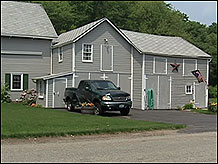Foreclosures to spike as new rates kick in
Study: 1.1 million more mortgage defaults expected over next 6 years.
NEW YORK (Reuters) -- About 1.1 million additional home foreclosures are expected over the next six years as adjustable-rate mortgages - which made home buying more affordable to U.S. buyers in recent years - reset to higher payments, according to a study by research firm First American CoreLogic.
The expected $112 billion in losses won't break the mortgage industry but will inflict pain on lenders and borrowers affected by the defaults, said the study, released Monday.

|
"It's less than we spend on alcohol. It's less than we spend on the lottery and gambling," said Christopher Cagan, director of research and analytics, and author of the report Mortgage Payment Reset, The Issue and the Impact.
"The price of gasoline has far more impact. We have $60 billion a month in trade deficit that dwarfs this," he added.
Some loans made over the past few years were designed to allow initial periods of low payments. Many of those were "teaser" loans, which called for very low initial interest rates. A large chunk of the initial low-interest and teaser-rate loans are scheduled to reset to higher and longer term rates. Some "negative amortization" loans will call for larger principal payments than the initial loan.
Many borrowers are likely to face the double-pressure of a large reset while at the same time, stagnant or fallen property values and little money down will leave many borrowers with no equity, or ownership in the home above the mortgage. That may hasten defaults and foreclosures.
The study forecasts that the defaults won't severely hurt the economy and will account for about 0.36 percent of the nation's gross domestic product. However, recent reports of default troubles in loans made to borrowers with weak credit histories helped send the stock market into a funk.
"That's what gets the attention," Cagan said. "The traffic report reports the accidents. It doesn't report the normal traffic."
The report focused on single-family residences and reviewed only the impact of loans that will reset to new rates. It also assumed that prices will stay level with those at the end of 2006. However, a 1 percent rise in national prices will cause 70,000 fewer loans to be lost from reset-driven foreclosures, while a 1 percent price decline will force an additional 70,000 into foreclosure.
The U.S. mortgage industry loans about $2 trillion each year, so the loses from foreclosures may be less than 1 percent of total lending, the report said.
"The problem is this falls on a slice of lenders, investors and borrowers - 1 or 2 percent of them - that gets stunned," Cagan said.
The percentage of loans resetting with negative equity is expected to leap from 12.9 percent in 2007 to 24.4 percent in 2008. That's when some of the most frequently used 2/28 mortgages, which called for two years of low payments and 28 years of higher payments, and 3/27 mortgages, which called for three years of low payments and 27 years of higher payments, are scheduled to reset.
Still, more than 93 percent of the 32 million single-family residences' valuations and loans in the study had positive equity.
The 1.1 million foreclosures represents about 13 percent of the adjustable-rate mortgages originated through purchase or refinance from 2004 to 2006, equaling about $326 billion in debt.
The study assumed that after all the foreclosure sales would be completed, about $112 billion would be lost.
But the study also projected that the pain would not be spread evenly. The "teaser" loan group is expected to see 32 percent of those mortgage defaults because of resetting, while 12 percent of sub-prime loans are expected to default. About 7 percent of market-rate adjustable loans are expected to default through resetting.
However, many lenders already are working with clients to modify terms or refinance existing loans to avoid default.
"Many lenders do not want an empty house on their hands or an empty condo, which will take them a year to sell and they have to pay maintenance, taxes and insurance," Cagan said.
Lenders such as Countrywide Financial (Charts), Wachovia (Charts) and Wells Fargo (Charts) are sensitive to rising foreclosure levels.

No comments:
Post a Comment